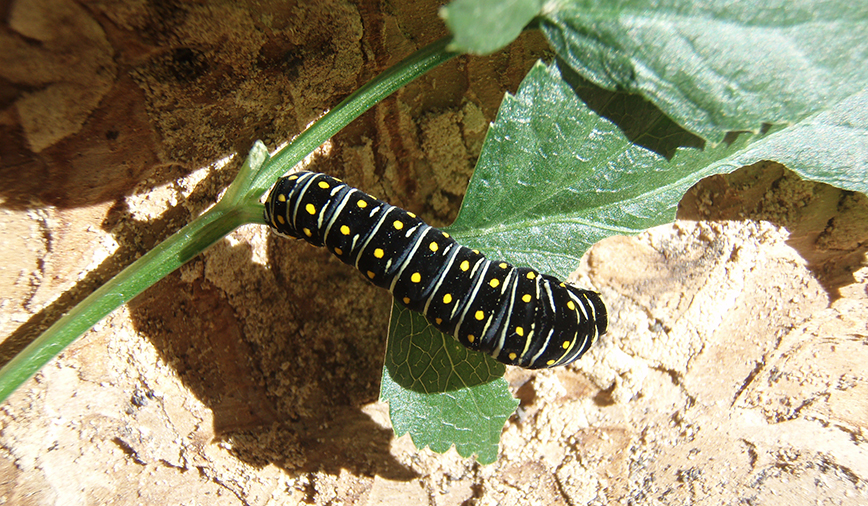The other day Joan Kramer, our gardener extraordinaire, came into the office and announced she’d found a friend in the garden.
Now, that in itself was nothing new. Joan’s always bumping into old friends, and making new ones, as she works to keep the park district’s Native Plant Garden in top-rate condition.
But this little pal was different indeed. All decked out in black and green, with just a touch of creamy yellow, this fellow was dapper. And quiet. Very, very quiet. He followed Joan wherever she went. But then again, he had no choice. He was stuck to a sprig of golden alexanders that she’d plucked and carried inside, then carried back out again.
All throughout his journey the little visitor remained motionless, probably, in his mind, to lessen his chances of getting eaten. Because that’s what life is like when you’re a black swallowtail caterpillar.
If all goes well, Joan’s friend will eat himself silly for the next couple of weeks, then travel to a suitable overwintering spot to molt and produce a chrysalis. There he’ll remain all winter long in a state of diapause, or suspended animation, before completing his metamorphosis in spring and emerging as a black swallowtail butterfly.
What he needs to do in the mean time, though, is avoid predation. Which is easier said than done.
Although birds and mammals tend to avoid black swallowtail caterpillars (their diet of plants in the parsley family makes them distasteful) the little larvae often fall victim to parasitic wasps that try to lay their eggs in the caterpillars’ flesh. To scare away these threats, plus any other predators who dare try to make a grab, the caterpillars are equipped with a “secret” weapon. Just behind the head, hidden inside a fleshy lump, lies the caterpillar equivalent of a fright mask equipped with a stink bomb—a small glandular sac called an osmeterium.
Most swallowtail caterpillars are outfitted with these nifty accoutrements. They differ a bit in size, color and shape, but their function is the same: To scare the heck out of anything that disturbs the caterpillar it belongs to.
The black swallowtail’s osmeterium is v-shaped and bright orange. When the caterpillar is disturbed, this small structure rises up from just behind the head, in much the same way Uncle Martin’s antennae rose up out of his head on the old sitcom My Favorite Martian.
Accompanying this startling display of color, supposedly, is a foul odor intended to reinforce the caterpillar’s message of “I am not edible!” The smell emanates from a mixture of chemicals derived from the caterpillar’s food plants.
Try as I might, I have yet to catch of whiff of this noxious odor. It’s reported to smell like rotten cheese. Mmm.
If you have a garden and grow plants in the parsley family, like carrots and parsnips, or dill—or parsley—you may already be acquainted with this caterpillar. And you may not be too fond of it. Its prodigious appetite means it can defoliate a plant in only a matter of days. But it does the same to Queen Anne’s lace, an introduced plant that can run rampant in natural areas if left unchecked.
Anything that eats Queen Anne’s lace is a friend of mine, and Joan’s. Keep an eye out for these engaging caterpillars over these next few weeks. Keep a nose out, too, while you’re at it. And if you find the caterpillar really does smell like rotten cheese, let me know, will you? Thanks, friend!
Pam Otto is the manager of nature programs and interpretive services for the St. Charles Park District. She can be reached at potto@stcparks.org or 630-513-4346.

